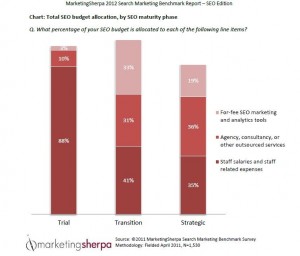Search and Email Marketing: Why these channels dominate
I always start an interview with general questions. I ask about the company, the marketer’s role, and the company’s marketing in general. It helps frame the case study or tactics we’re about to cover.
I sometimes ask, “What are your top marketing channels?” This helps me understand the team’s priorities. Some say ‘catalogs’ or ‘telesales,’ but the two channels I most often hear are email marketing and search.
Again and again, marketers say one or both of these channels are the primary drivers of their success. That got me thinking about the similarities between email and search engine optimization (SEO)/pay-per-click (PPC). I came up with three:
Similarity #1. Good bang for the buck
As far as money goes, email marketing is not a huge cost driver. The portion of the online marketing budget (not even the entire marketing budget) consumed by email is
- 16% in B2B companies
- 12% in B2C companies
(According to the MarketingSherpa 2011 Email Marketing Benchmark Report.)
The return on this investment is often large, as you can see in the below chart from the email benchmark report. With such returns, email marketing can be extremely efficient.
The combination of SEO and PPC generates larger financial costs. On average, 25% of an online marketing budget goes to PPC and 21% goes to SEO, according to the MarketingSherpa 2012 Search Marketing Benchmark Report — SEO Edition.
Search can be very effective, though, with 41% of marketers saying at least one-quarter of their leads come from paid search, and 35% saying at least one-quarter of leads come from natural search, according to the MarketingSherpa 2012 Search Marketing Benchmark Report – PPC Edition.
Similarity #2. Relevant audiences
I believe a key driver of effectiveness in email and search marketing is the ability of each channel to reach a targeted audience.
Email subscribers are not random people. They have agreed to receive communications from your brand and are interested in the content and offers you send. Email marketing gives you the ability to send messages to an extremely niche audience, and even segment and target your content to further increase relevance. This is not possible with a platform as broad as, say, television advertising.
People viewing and clicking on your natural and paid search results are not random people, either. They are searching for specific terms, and a search engine has determined that your webpage is related to those terms. This pre-qualifies the traffic. Visitors further qualify themselves by reading and clicking your result. This pushes a relevant audience to your website.
Similarity #3. Significant investments in time
The amount of time invested into email or search marketing can eclipse the amount of money invested. A push-button solution does not exist, even for PPC (think of all the keyword research, testing and bid adjustments).
Also, the chart below from our SEO benchmark guide shows staff salaries as generating the largest SEO expense in many organizations.
Sure, you can hire an agency, but even the best will require time. They will still have to build an effective list for your email marketing. They will need to consistently add content to your site to feed the search spiders. They will need to constantly analyze and adjust your paid search bids.
The best approach in these channels is to start with an effective strategy, as well as an effective platform, and consistently execute — day, after day, after day.
Related Resources:
SEO: How to launch a website redesign without hurting search rankings and traffic
Marketing Research Chart: SEO budgets for 2012
Marketing Research Chart: Difficulty in execution of PPC tactics is not barrier to usage
Email Marketing: How to overcome segmentation challenges and deliver targeted content
Email Relevance: 8 tactics for leveraging timing, segmentation and content
Email Marketing: Show me the ROI
Categories: Email Marketing, Search Marketing channels, Email Marketing, online marketing budgets, pay-per-click, Search Marketing, SEO











